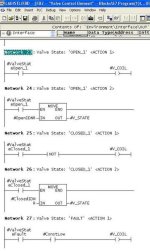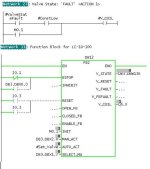Hi!
I'm having a weird issue with programming my own function blocks. For some reason unknown to me, I can not set any of my boolean outputs in my function blocks?
Even though all conditions have been met to set a "1" on the block output, this simply does not happen. I've opend up the instance data block in a VAT, and seen that if the address 20.3 is high then the output 4.3 should be high, however this does not happen.
The only thing that apparently "fixes" the issue, is to delete the output and create a new one with a new symbolic name at a different address. This "fix" only lasts until i turn of the PLC and disconnect STEP 7. If i re-upload the block to the PLC the same fault appears again.
In the same block i have outputs of other types, like INT. These work perfectly everytime. If I cant solve this issue I'll have to scrap all of my custom function blocks and re-write most of my program.
The PLC in question is a Siemens S7-300 series with a 315-2 DP CPU. STEP 7 is Ver 5.4.
If anyone has any ideas on how to solve this, then any help would be highly appreciated.
DanJack.
I'm having a weird issue with programming my own function blocks. For some reason unknown to me, I can not set any of my boolean outputs in my function blocks?
Even though all conditions have been met to set a "1" on the block output, this simply does not happen. I've opend up the instance data block in a VAT, and seen that if the address 20.3 is high then the output 4.3 should be high, however this does not happen.
The only thing that apparently "fixes" the issue, is to delete the output and create a new one with a new symbolic name at a different address. This "fix" only lasts until i turn of the PLC and disconnect STEP 7. If i re-upload the block to the PLC the same fault appears again.
In the same block i have outputs of other types, like INT. These work perfectly everytime. If I cant solve this issue I'll have to scrap all of my custom function blocks and re-write most of my program.
The PLC in question is a Siemens S7-300 series with a 315-2 DP CPU. STEP 7 is Ver 5.4.
If anyone has any ideas on how to solve this, then any help would be highly appreciated.
DanJack.
Last edited:








